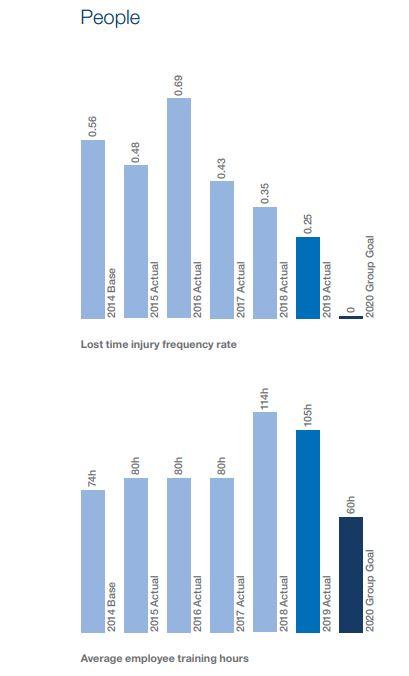The People at Sappi Remain Central to Sustainability Strategy
The people at Sappi remain central to sustainability strategy
Achieve zero workplace injuries
Safety is the top priority at Sappi. Across all regions, we are committed to zero workplace injuries. The metric we use to measure our progress toward meeting our goal is known as lost time injury frequency rate (LTIFR), which measures injuries resulting in lost time per 200,000 employee hours of exposure—equivalent to 100 full-time employees per year.
In 2019, we achieved an LTIFR of 0.25, our bestever reported performance. Of note, both our Allentown sheeting facility and the Technology Center achieved zero workplace incidents. The Cloquet Mill sustained only one lost-time injury and posted a very strong performance of 0.13 LTIFR.
Achieve 60 training hours per year, per employee
SNA’s regional goal for employee training is 60 hours per employee (hourly and salaried, on average). In FY19, we achieved an average of 105 hours per employee, with a particular focus on the manufacturing operations. This strong performance reflects our significant commitment to training across all employees in the organization and covering safety competence and skills.
Promoting employee engagement
Every two years, the entirety of Sappi group undertakes the Willis Towers Watson Employee Engagement Survey, from which we’ve established two metrics for employee engagement. The first goal was to increase employee survey participation to 73%, which is 2% above the previous survey results. This year, our survey participation dropped to 68%. The second goal was to increase sustainable engagement by two percentage points to reach 79%. Sustainable engagement is determined by employee responses to survey questions such as commitment to company goals, discretionary effort, and recognition. We fell just short with a response result of 78%.
Our strategies to improve survey participation and sustainable engagement include enhanced training, stronger supervisory skills, and better employee communications specific to the lower scoring organizational areas.
Read more from Sappi North America's 2019 Sustainability Report here:.



